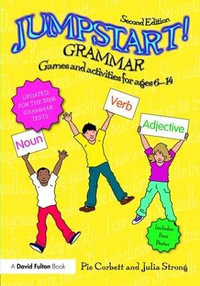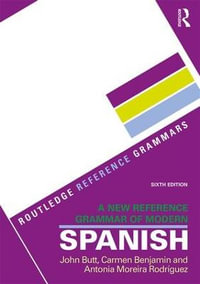
Language Typology and Syntactic Description
Volume 2, Complex Constructions
Hardcover | 4 October 2007 | Edition Number 2
At a Glance
488 Pages
Revised
22.86 x 15.24 x 3.18
Hardcover
RRP $169.95
$151.75
11%OFF
or 4 interest-free payments of $37.94 with
orShips in 5 to 7 business days
| List of figures | p. xi |
| List of tables | p. xii |
| List of contributors | p. xiii |
| Acknowledgements | p. xiv |
| List of abbreviations and symbols | p. xvi |
| Parts-of-speech systems | p. 1 |
| Introduction | p. 1 |
| Open classes | p. 3 |
| Nouns | p. 5 |
| Verbs | p. 9 |
| Adjectives | p. 13 |
| Adverbs | p. 19 |
| Closed classes | p. 22 |
| Pronouns and other pro-forms | p. 24 |
| Noun adjuncts | p. 34 |
| Verb adjuncts | p. 40 |
| Conjunctions | p. 45 |
| Other closed classes | p. 52 |
| Suggestions for further reading | p. 60 |
| Word order | p. 61 |
| Introduction | p. 61 |
| Some basic word order correlations | p. 61 |
| Verb-final languages | p. 61 |
| Verb-initial languages | p. 64 |
| svo languages | p. 68 |
| Object-initial languages | p. 71 |
| Interim summary | p. 72 |
| Conclusion | p. 73 |
| Identifying basic word order | p. 73 |
| Identifying constructions cross-linguistically | p. 78 |
| Identifying the order of subject, object, and verb | p. 78 |
| Identifying subjects | p. 78 |
| The order of subject, object, and verb | p. 79 |
| Lexical noun phrases versus pronouns | p. 80 |
| Identification of manner adverbs | p. 80 |
| Identification of prepositions and postpositions | p. 81 |
| Adpositions versus case affixes | p. 82 |
| Case affixes versus adpositional clitics | p. 82 |
| Adpositions and relational nouns | p. 85 |
| Languages without adpositions | p. 86 |
| Identification of genitives | p. 86 |
| Alienable versus inalienable possession | p. 86 |
| Lexical genitives versus possessive pronouns | p. 87 |
| Exceptions to word order generalizations | p. 87 |
| Other word order characteristics that correlate with the order of object and verb directionally | p. 89 |
| Verb and adpositional phrases | p. 89 |
| Verb and non-argument noun phrases | p. 90 |
| Main verb and auxiliary verb | p. 90 |
| Copula verb and predicate | p. 91 |
| Question particles | p. 91 |
| Complementizer and clause | p. 93 |
| Article and noun | p. 94 |
| Subordinate and main clause | p. 96 |
| Word order characteristics that correlate with the order of object and verb unidirectionally | p. 96 |
| Noun and relative clause | p. 96 |
| Plural word and noun | p. 98 |
| Intermediate unidirectional and bidirectional cases | p. 99 |
| Subordinator and clause | p. 99 |
| Complementizer and clause | p. 100 |
| Word order characteristics that do not correlate with the order of object and verb | p. 101 |
| Adjective and noun | p. 101 |
| The absence of a correlation with the order of object and verb | p. 101 |
| Identifying adjectives | p. 102 |
| Demonstrative and noun | p. 104 |
| Numeral and noun | p. 105 |
| Negative particle and verb | p. 105 |
| Tense-aspect particle and verb | p. 107 |
| Degree word and adjective | p. 107 |
| Other typological characteristics correlating with the order of object and verb | p. 108 |
| Position of interrogative expressions in content questions | p. 108 |
| Affix position | p. 110 |
| The use of case in distinguishing transitive arguments | p. 110 |
| Other sorts of implicational generalizations | p. 110 |
| Order among elements at the same level | p. 111 |
| Languages with flexible word order | p. 113 |
| Typological versus language-particular description of word order | p. 114 |
| Examples of summaries of word order properties | p. 115 |
| Siyin Chin | p. 116 |
| Batad Ifugao | p. 120 |
| Summary | p. 129 |
| Suggestions for further reading | p. 130 |
| The major functions of the noun phrase | p. 132 |
| Introduction | p. 132 |
| Preliminaries | p. 135 |
| Semantic roles | p. 135 |
| Agent and patient | p. 137 |
| Other semantic roles | p. 140 |
| Coding strategies | p. 141 |
| Order and arrangement | p. 141 |
| NP-marking | p. 142 |
| Cross-referencing | p. 145 |
| Pragmatic functions | p. 148 |
| Topics and topic-comment articulation | p. 149 |
| Focus-presupposition articulation | p. 150 |
| Thetic articulation | p. 150 |
| Overview of grammatical functions | p. 152 |
| Types of grammatical function | p. 152 |
| External functions | p. 154 |
| Oblique functions | p. 157 |
| Obliques (PPS) in English | p. 157 |
| Obliques in Warlpiri | p. 161 |
| Core grammatical functions | p. 164 |
| Subjects | p. 165 |
| A concept of subject | p. 166 |
| Subjects and coding features in ordinary main clauses | p. 166 |
| Subject ellipsis | p. 168 |
| Coding features in non-main clauses | p. 174 |
| Switch reference | p. 176 |
| Reflexivization | p. 177 |
| Other properties of subjects | p. 179 |
| Other core grammatical relations | p. 180 |
| Direct objects and second objects | p. 180 |
| Indirect objects | p. 188 |
| Other core relations | p. 191 |
| Syntactic ergativity | p. 193 |
| Reconsidering grammatical relations | p. 197 |
| Mixed syntactic ergativity | p. 198 |
| The Philippine type | p. 202 |
| The universal status of a- and p-subjects | p. 211 |
| Manipuri | p. 212 |
| Split intransitivity | p. 216 |
| Conclusion | p. 222 |
| Suggestions for further reading | p. 222 |
| Clause types | p. 224 |
| Introduction | p. 224 |
| Nonverbal predicates | p. 224 |
| Types of copulas | p. 225 |
| Adjectival predicates | p. 227 |
| Nominal predicates | p. 229 |
| Equational clauses versus clauses with true nominal predicates | p. 233 |
| Optional copulas | p. 236 |
| Locative predicates / existential clauses | p. 238 |
| Locative copulas | p. 238 |
| Existential clauses | p. 240 |
| Existential clauses for expressing predicate possession | p. 244 |
| Other types of existential clauses | p. 246 |
| Minor types of clauses with nonverbal predicates | p. 247 |
| Verbal predicates | p. 250 |
| Transitive versus intransitive clauses | p. 250 |
| Ergative versus accusative patterns | p. 251 |
| Ditransitive clauses | p. 253 |
| Subtypes of intransitive clauses | p. 259 |
| Stative versus nonstative clauses | p. 259 |
| Split intransitivity | p. 261 |
| Zero-intransitive (or ambient) clauses | p. 267 |
| Semi-transitive clauses | p. 270 |
| Clauses with derived verbs | p. 274 |
| Suggestions for further reading | p. 275 |
| Speech act distinctions in grammar | p. 276 |
| Speech acts and sentence types | p. 276 |
| Declarative sentences | p. 284 |
| Declaratives in relation to the other basic types | p. 285 |
| Interaction with evidentiality | p. 288 |
| Interrogative sentences | p. 290 |
| Polar interrogatives | p. 292 |
| Intonational marking | p. 292 |
| Interrogative particles | p. 294 |
| Interrogative tags | p. 296 |
| Disjunctive-negative structures | p. 297 |
| Change in the order of constituents | p. 298 |
| Verbal inflection | p. 299 |
| Constituent interrogatives | p. 299 |
| Imperative sentences | p. 303 |
| Positive imperatives | p. 304 |
| Negative imperatives (prohibitives) | p. 308 |
| Indirect strategies | p. 311 |
| Related constructions | p. 313 |
| Some minor sentence types | p. 316 |
| Exclamatives | p. 316 |
| Echo questions | p. 319 |
| Nonfinite presentatives | p. 319 |
| Answers to questions | p. 320 |
| Summary and conclusion | p. 322 |
| Suggestions for further reading | p. 323 |
| Passive in the world's languages | p. 325 |
| Introduction | p. 325 |
| Passive as a foregrounding and backgrounding operation | p. 325 |
| Basic passives | p. 328 |
| General properties of basic passives | p. 328 |
| The syntactic form of basic passives | p. 332 |
| Strict morphological passives | p. 333 |
| Periphrastic passives | p. 336 |
| The semantics of basic passives | p. 339 |
| Aspectual differences | p. 340 |
| Degree of subject affectedness | p. 341 |
| Non-basic passives | p. 342 |
| Passives with agent phrases | p. 342 |
| Agent phrases in non-passive constructions | p. 342 |
| The form of agent phrases | p. 343 |
| Passives on non-transitive verbs | p. 345 |
| Passives on ditransitive verb phrases | p. 348 |
| Other passives with non-patient subjects | p. 350 |
| Constructions that resemble passives | p. 352 |
| Middles | p. 352 |
| Unspecified subject constructions | p. 354 |
| Inverses | p. 356 |
| Antipassives | p. 359 |
| The functional load of passive in grammars | p. 359 |
| Suggestions for further reading | p. 361 |
| A typology of information packaging in the clause | p. 362 |
| Introduction | p. 362 |
| On verbal semantics and packaging options | p. 364 |
| Conceptual events, participants, and perspective | p. 364 |
| Parameters governing actor choices | p. 370 |
| Parameters governing undergoer choices | p. 374 |
| Intransitive verbs and the unaccusative/unergative split | p. 380 |
| On argument structure and pivots | p. 383 |
| The nature of argument structure | p. 383 |
| The notion of pivot | p. 389 |
| A typology of pivots | p. 394 |
| On information structure | p. 402 |
| The discourse status of noun phrases | p. 402 |
| The information status of noun phrases | p. 409 |
| The animacy hierarchy | p. 413 |
| Topics, pivots, and prominence | p. 416 |
| On voice: clause-internal packaging options | p. 418 |
| Passive constructions | p. 418 |
| Foregrounding passives | p. 422 |
| Backgrounding passives | p. 423 |
| Summary | p. 427 |
| Antipassive constructions | p. 429 |
| Foregrounding antipassives | p. 430 |
| Backgrounding antipassives | p. 433 |
| Applicative constructions | p. 437 |
| Summary of clause-internal packaging constructions | p. 441 |
| On clause-external packaging options: topicalizations, left dislocations, and right dislocations | p. 442 |
| Suggestions for further reading | p. 446 |
| Bibliography | p. 447 |
| Subject index | p. 470 |
| Table of Contents provided by Ingram. All Rights Reserved. |
ISBN: 9780521581578
ISBN-10: 0521581575
Published: 4th October 2007
Format: Hardcover
Language: English
Number of Pages: 488
Audience: Professional and Scholarly
Publisher: Cambridge University Press
Country of Publication: GB
Edition Number: 2
Edition Type: Revised
Dimensions (cm): 22.86 x 15.24 x 3.18
Weight (kg): 0.89
Shipping
| Standard Shipping | Express Shipping | |
|---|---|---|
| Metro postcodes: | $9.99 | $14.95 |
| Regional postcodes: | $9.99 | $14.95 |
| Rural postcodes: | $9.99 | $14.95 |
Orders over $79.00 qualify for free shipping.
How to return your order
At Booktopia, we offer hassle-free returns in accordance with our returns policy. If you wish to return an item, please get in touch with Booktopia Customer Care.
Additional postage charges may be applicable.
Defective items
If there is a problem with any of the items received for your order then the Booktopia Customer Care team is ready to assist you.
For more info please visit our Help Centre.
You Can Find This Book In
![Collins Easy Learning Complete French Grammar, Verbs and Vocabulary (3 Books In 1) [2nd Edition] : Trusted Support for Learning - Collins Dictionaries](https://www.booktopia.com.au/covers/200/9780008141721/3544/collins-easy-learning-complete-french-grammar-verbs-and-vocabulary-3-books-in-1-2nd-edition-.jpg)
Collins Easy Learning Complete French Grammar, Verbs and Vocabulary (3 Books In 1) [2nd Edition]
Trusted Support for Learning
Paperback
RRP $27.99
$20.99
OFF

German Tutor : Grammar and Vocabulary Workbook (Learn German with Teach Yourself)
Practise German with Teach Yourself
Paperback
RRP $49.99
$37.99
OFF
























